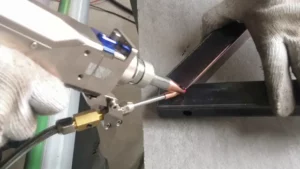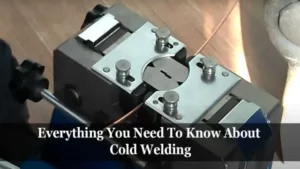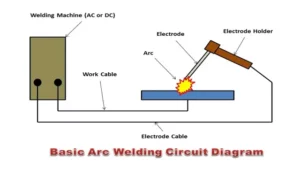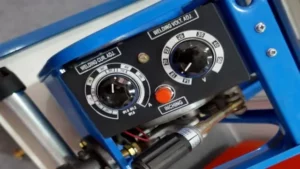Inductance is an important concept in welding that is often overlooked or misunderstood. However, its impact on the quality of the weld cannot be overstated. Inductance is a measure of the opposition of a circuit to a change in current and is a characteristic of the welding machine.
It determines how quickly the current rises in the welding circuit and how it is maintained during the welding process. Understanding inductance is essential in achieving high-quality welds, improving arc stability, and preventing issues such as spatter, porosity, and incomplete fusion. In this blog post, we will explore the concept of inductance in welding in-depth to improve your welding knowledge.
Introduction
If you’re new to welding, you might be wondering what the inductance setting does on your welding machine. Essentially, the inductance setting regulates the flow of electricity during the welding process. It controls how quickly the electrical current increases and decreases, which affects the heat and penetration of the weld.
When you increase the inductance, the electrical current rises and falls more slowly, resulting in a softer, smoother arc. Conversely, lowering the inductance will create a faster, more forceful arc with deeper penetration. Ultimately, the inductance setting depends on the type of welding you’re doing and the thickness of the material, so it’s important to experiment with different settings until you find what works best for your specific project.
Explanation of Inductance
Inductance Introduction: When it comes to understanding electricity and how it works, inductance is a concept that often comes up. Inductance is the property of a conductor or circuit that opposes the change in electric current flowing through it. It is caused by the magnetic field that is created around a conductor as a result of the current flowing through it.
This magnetic field can interact with the magnetic fields of other conductors or circuits nearby, creating a self-inductance or mutual inductance. Understanding how inductance works is essential for electrical engineers, as it can affect the performance of circuits and the behavior of electrical components. In this article, we will explore inductance further and discuss its importance in electronics.
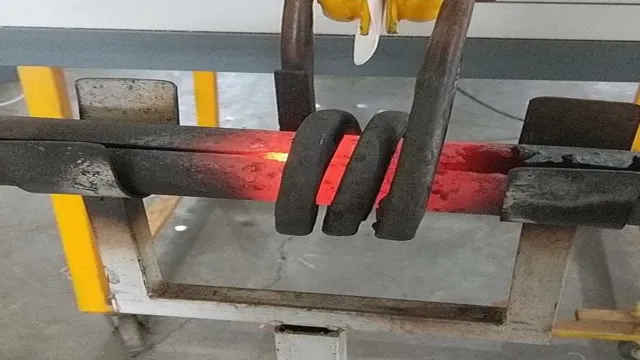
Importance of Inductance in Welding Process
Inductance in Welding Process Welding is an important process that is used in various industries like construction, manufacturing, and automotive. The welding process involves joining two or more pieces of metal by heating them to a point where they melt and fuse together. However, in order to ensure a strong, efficient, and safe weld, it is important to take into consideration the role of inductance in the welding process.
Inductance in welding refers to the relationship between the electrical current and the magnetic field in the welding circuit. Put simply, inductance is the ability of an electrical circuit to resist abrupt changes in current by storing energy in a magnetic field. In welding, inductance plays a crucial role in controlling the amount of heat generated during the welding process.
A high inductance value will result in a slower increase in current and a more gradual buildup of heat in the welding arc. This is especially useful when welding materials with higher melting points like stainless steel or aluminum. On the other hand, a low inductance value will result in a faster build-up of heat, which is useful for welding thinner materials.
In conclusion, inductance plays a crucial role in the welding process by controlling the amount of heat generated during welding. This helps to ensure a strong and efficient weld, as well as ensuring safety in the welding process. By understanding the importance of inductance, welders can be more effective and efficient in their work, resulting in higher quality welds and safer work environments.
Effects of Inductance on Welding
If you’re wondering what the inductance setting does on your welding machine, you’re not alone. Inductance refers to the ability of a material to generate an electromagnetic field, which can influence the welding process. In welding, inductance is mainly used to control the amount of current flowing through the welding circuit.
By adjusting the inductance setting, you can control the arc behavior, including its stability and penetration depth. High inductance settings tend to create a steadier arc with a deeper weld penetration, while lower inductance settings create a sharper arc with a shallower penetration depth. However, it’s important to note that the specific effects of inductance can vary depending on the type of welding process and materials you’re working with, so it’s always a good idea to consult your welder’s manual or a professional for guidance.
Lower Inductance Effects
Lower inductance effects can have a significant impact on welding. Inductance, in simple terms, is the resistance to a change in electrical current. If the inductance is too high, it can cause excessive spatter, which can result in a poor weld.
On the other hand, if the inductance is too low, it can cause a cold weld, which can lead to a weak joint. The optimal inductance setting depends on the type of welding being done, the type of metal being used, and the electrode being used. As such, it is essential to understand the effects of inductance on welding to determine the optimal setting for a specific project.
By using the right inductance setting, welders can ensure that they create high-quality welds that are strong and durable.
Higher Inductance Effects
When it comes to welding, the inductance level can have a significant effect on the outcome of the process. Higher inductance can lead to a slower build-up of heat, which can result in a narrower welding bead and less penetration. This can be a positive or negative effect depending on the type of project and the desired outcomes.
However, if the inductance is too high, it can lead to spatter and lack of fusion, which can ultimately negatively impact the quality of the weld. It’s important to find the right balance when it comes to inductance levels to ensure the best possible results.
Ideal Inductance Range for Different Welding Processes
When it comes to welding, the inductance of the welding machine plays a significant role in the overall quality of the weld. Inductance is a measure of the welding power source’s ability to change the welding current, and it affects the shape, penetration, and profile of the weld. Depending on the welding process, the ideal range of inductance may vary.
For example, in MIG welding, higher inductance values result in a broader and flatter bead profile, while in TIG welding, lower inductance values are preferred, resulting in a narrower and deeper weld. In general, the ideal inductance range for MIG welding is between 8 and 12, while TIG welding can generally benefit from an inductance range of 2 to However, it’s important to note that these values may vary depending on the specific materials being welded and the welding technique used.
Choosing the right inductance for a given welding process is crucial for achieving a high-quality weld.
Adjusting Inductance on your Welding Machine
If you’re wondering what the inductance setting does on your welding machine, you’re not alone. Inductance refers to the resistance of electrical current in a circuit, and adjusting the inductance setting on your welding machine can affect the quality and performance of your weld. Typically, higher inductance settings result in a smoother, steadier arc, while lower inductance settings increase the intensity and penetration of the weld.
Essentially, adjusting your welding machine’s inductance setting allows you to fine-tune the welding process to suit your specific needs and achieve the desired results. So, next time you’re working on a welding project, consider experimenting with the inductance setting on your machine to see how it can impact your welds.
How to Adjust Inductance on Different Welding Machines
Adjusting the inductance on your welding machine can drastically affect the quality of your welds. The inductance setting controls the rate at which the welding current rises and falls, which in turn affects the penetration and overall appearance of your welds. To adjust the inductance on your welding machine, start by understanding the specific control or setting that controls inductance.
On some machines, this may be labeled as “inductance” or “L,” but on others, it may be controlled through a different setting. Once you’ve identified the correct setting, use trial and error to find the right inductance level for your specific welding project. Remember, higher inductance levels will generally result in more spatter, while lower levels may result in a lack of penetration.
It’s important to test your welds at different inductance levels to determine the perfect setting for your specific project. By adjusting the inductance on your welding machine, you can ensure high-quality welds every time.
Inductance Settings for Specific Welding Tasks
Inductance Adjusting the inductance on your welding machine is an essential aspect of achieving high-quality welds. Whether you are working with aluminum, stainless steel, or mild steel, you must have a clear understanding of how inductance affects your welding output. To set up your welding machine for specific tasks, you first need to know the optimal inductance level required for that task.
For example, when working with thin materials, a lower inductance level is ideal, while thicker materials require higher inductance levels to achieve a stable arc. Moreover, inductance settings also impact how much control you have over the weld pool, and the speed at which you can complete the task. By optimally adjusting your inductance settings, you can avoid welding defects such as undercutting, porosity, or lack of fusion.
In summary, inductance plays a significant role in achieving high-quality welds, and understanding how to adjust it correctly for specific tasks is crucial.
Conclusion
In conclusion, the inductance setting on your welding machine is like the seasoning in a gourmet meal – it may seem like a small element, but it can make a huge difference in the end result. Just as too much salt can ruin a dish, an incorrect inductance setting can lead to poor weld quality, while the right amount can enhance penetration and improve overall efficiency. So, when it comes to welding, don’t underestimate the power of the inductance setting – it may just be the secret ingredient to taking your welds from good to gourmet!”
FAQs
What is inductance setting on a welding machine?
Inductance setting on a welding machine controls the current response of the machine’s welding output. It affects the rate at which welding current increases and decreases.
How does inductance setting affect my welding?
Lower inductance settings result in a faster rise and fall of welding current, resulting in a more aggressive, spatter-prone welding process. Higher inductance settings result in a slower rise and fall of welding current, providing a more stable, smoother welding arc.
What factors should I consider when adjusting inductance setting?
The thickness of the metal being welded, the desired welding speed, the type of welding process being used, and the welding position are all factors to consider when adjusting inductance settings.
Can inductance setting be used to control penetration in welding?
Yes, inductance setting plays a crucial role in controlling weld penetration by adjusting the amount of heat delivered to the workpiece.
Should inductance setting be adjusted during welding?
Inductance settings are usually adjusted before the welding process begins, but they can be adjusted during the welding process based on the changes in welding position, metal thickness, or desired welding speed.
How can I find the optimal inductance setting for my welding project?
The optimal inductance setting for a welding project can be determined through trial and error, by adjusting the inductance setting until the desired welding outcome is achieved.
Do all welding machines have inductance setting?
No, not all welding machines have the inductance setting feature. It is commonly found in advanced welding machines used for professional welding applications.

